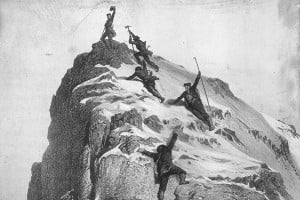
Talk of the Dolomites and most people either don't know what you're talking about, or they instantly start talking about vertiginous Via Ferrata and ridiculous rock climbing lines up soaring cliffs. These mountains, despite their modest stature and proximity to a road head or a ski lift offer some of the finest alpine rock one can find. But there is also a lack of information about other activities which puts people off – the reality is there is so much more to these mountains than just the normal activities your average Briton knows about.
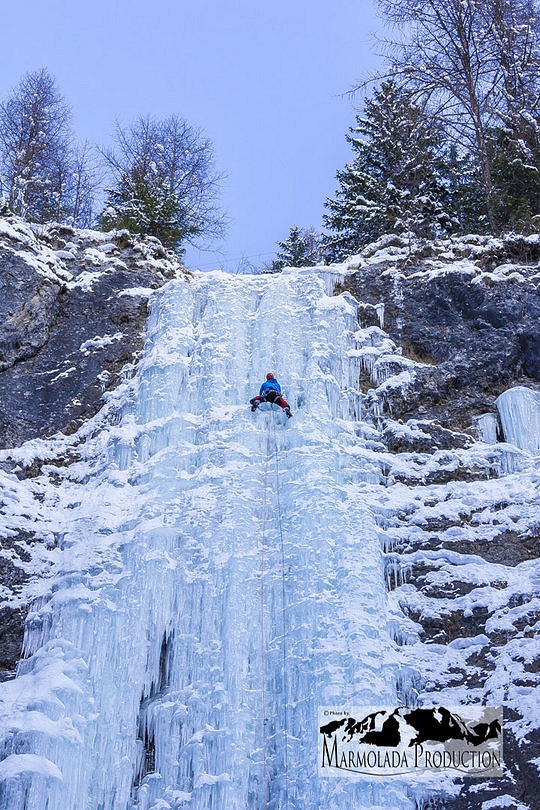
Take for example Illuminati (WI-6+), the 3 pitch M11+/WI 6+ in Vallunga. This simply stunning, world class hard mixed route takes a line up a series of overhangs out of an enormous cave to a very delicate curtain of suspended ice daggers. You would have thought that Greg Boswell and Albert Leichfried's repeat of the now infamous route which was widely reported by UKC would get the average winter climber thinking. But it is a very rare sight indeed to meet another Brit ice climbing in these beautiful mountains. So I'm here to tell you, there's ice climbing in them there mountains and I'm telling you, it's awesome.
And the crown jewel of the region is the Serrai di Sottoguda. Where I hear you ask. It's got to be Italy's best kept ice climbing secret. If you're looking for consistent ice, a variety of grades and routes, a mix of cascade ice and mixed climbing, a large number of routes with a 5 minute walk in, easy access from an airport served year round by a multitude of airlines and from different airports and maybe something that's ridiculously beautiful to look at and then climb, then look no further.
The Serrai di Sottuguda is a deep slash through the base of Val Pettorina formed during the ice ages as glacial meltwater gouged down through the rock. It is a UNESCO site, as is Marmolada which towers above the gorge to the west. So narrow in places that the walls almost meet, this natural phenomenon ticks every box you can think of as an ice climber. With a total of 29 routes in the guide book (and a bunch which aren't!), it's a destination which is virtually unknown by British winter climbers, and with visitors flocking to destinations like Rujkan, Cogne, the Cremerie and La Grave you have to wonder why.
Information. Or the lack there of. With the guidebooks for these parts mainly in Italian or German and with no translation available, most Brits are put off – we're famous for only speaking pidgin French! But we're missing a trick; the valley which faces east-west is very deep, hidden from the sun through most of the winter and acts as a cold sink for air dropping from Marmolada's glacial north face. With temperatures in November usually in the minus figures and water pouring into the 150m deep gorge from both sides of the valley, conditions couldn't more perfect for an ice climber.
The Climbing
The routes in the gorge are varied and interesting, ranging from short, easy beginner/warm up routes through to a 60m WI6 pitch as part of a 100m line; from short brutal drytooling routes through to M9+ routes. Mostly fully attached pillars, there are also some detached pillars and stalactites. There are some truly superb lines – notably Excalibur, La Catedrale, Cascata delle Attraversate, La Spada nella Roccia and Cascata del Sole – all in the WI3+ to 5 range, and all with circa 80-100m of fantastic climbing. This is not to do down the quality of the other lines; in amongst the towering walls there are lesser lines which in the UK would be notable in themselves.
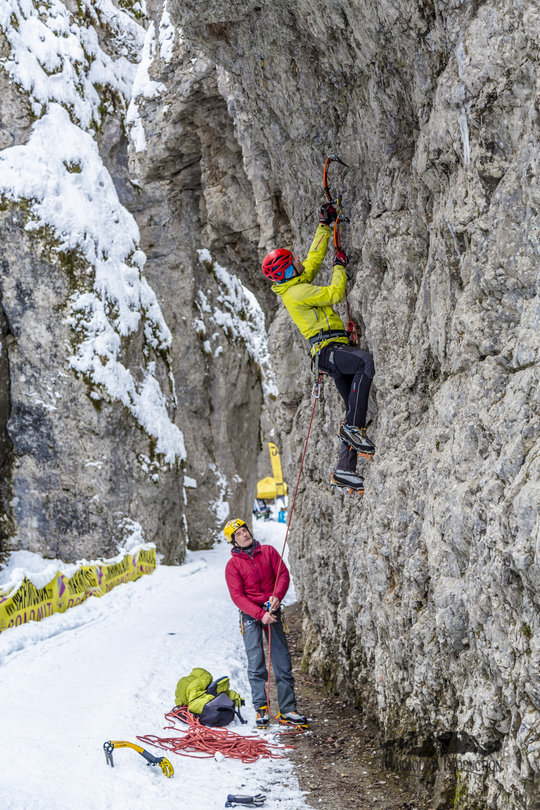
And what do you do when you get bored of the gorge? Well within a 30 minute drive there are numerous other high quality venues. Just 5 minutes from the end of the valley, the ice fall at Laste and Digonera are excellent as well, in a more open setting. Cross Passo Fedaia to Canazei and you will find again, more routes than you can shake a stick at within a short walk from a convenient car park. Corvara has some superb routes, whilst explore the Agordino Valley and you will find many hidden, rarely climbed gems.
The Classics
Over its 2km length, amongst its 29+ lines, the gorge has a great number of classic routes.
Catedrale Destra, Centrale and Sinistra:
More of an area, these are the main falls in the gorge. It's a 50m wide free for all cascade, but it has 3 main lines, all of which are classic and see very regular ascents, with perhaps the exception of "sinistra", the WI 6 mammoth at the far left side of the falls. Walking up the gorge, the falls are utterly unmistakable as they are simply huge.
Destra (V+) WI4+, 2 pitch, 100m ***
Several lines possible, with a max of 2 freestanding pillars forming to the right of the falls. Climb WI 4 lines of your choosing to the halfway ledge. In the rock section, you will find at least 2 fixed belay/abseil stations. Then choose between the Right, Central or Left hand lines. All are steep mushroomed ice. The pillars take time to form but are often thick and solid. Be careful with the left hand variant exit as it can be thin in early season.
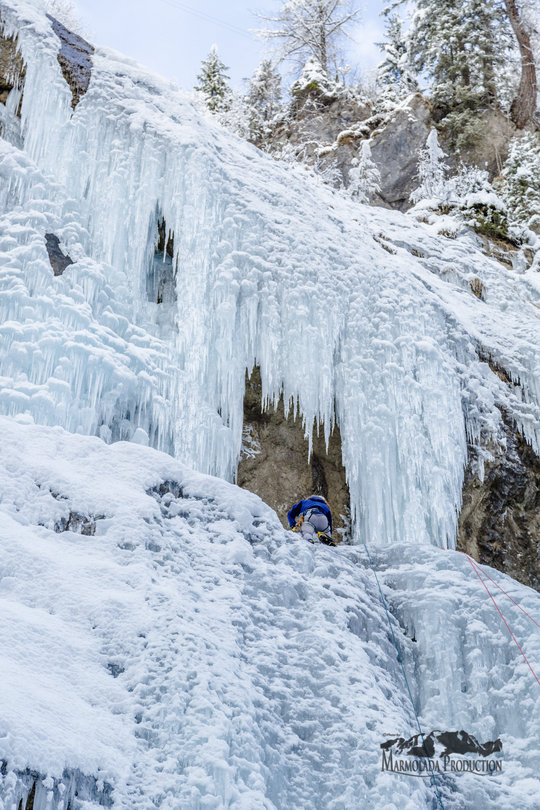
Centrale WI5, 2 pitches, 100m ***
The first pitch attacks the steep central groove of the first tier. The second follows a wide steep wall with relatively few spots to take a break.
Sinistra (VI+), WI5+/6, 2 pitches, 100m ***
The left hand variant is usually the last to form as it is an immensely slender column of ice, with intricate, steep climbing. The main upper pitch is a colossal 60m pitch and it's truly breath taking to watch climbers picking their way up it.
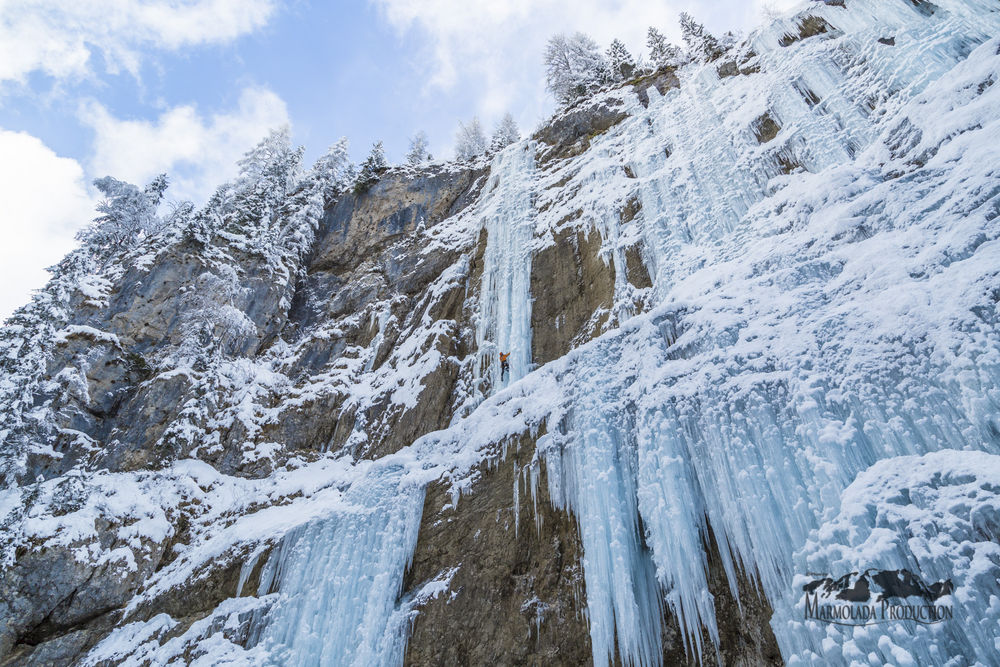
All of the first pitches are frequently climbed in their own right and on many lines, usually dependent on where the boulders are located in the stream bed this year!
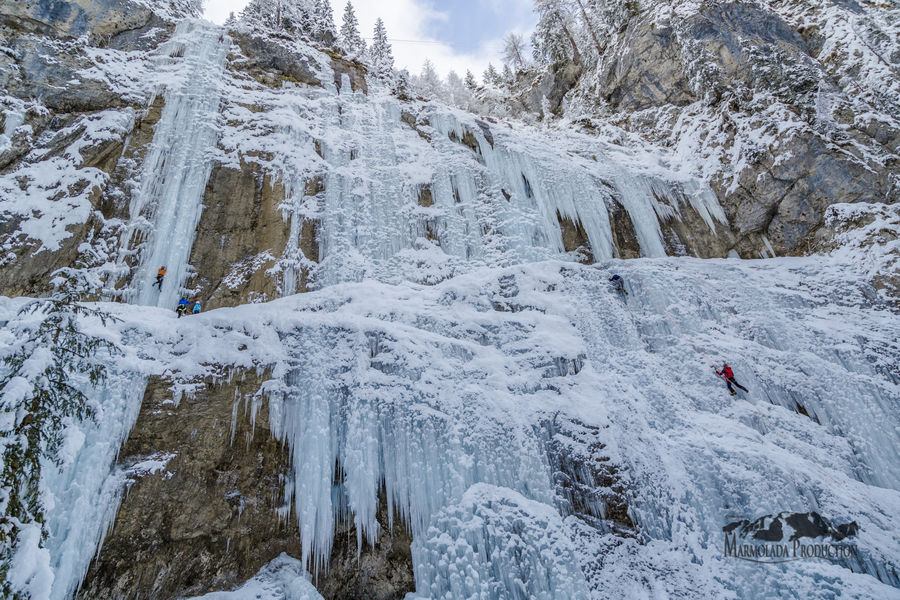
Spada Nella Roccia (WI-2), WI5, 1 pitch, 40m ****
This is a route of national importance and the first ascent during the 80's represented a major leap forwards as far as Piolet Traction was concerned. As such it is regarded as one of the finest routes in Italy, if not the Alps. Dropping directly from a ledge beneath a road bridge, the route is unremittingly steep, although its nature is often highly featured. Generally climbed on its right hand side, you will need a full complement of screws to tackle this route.
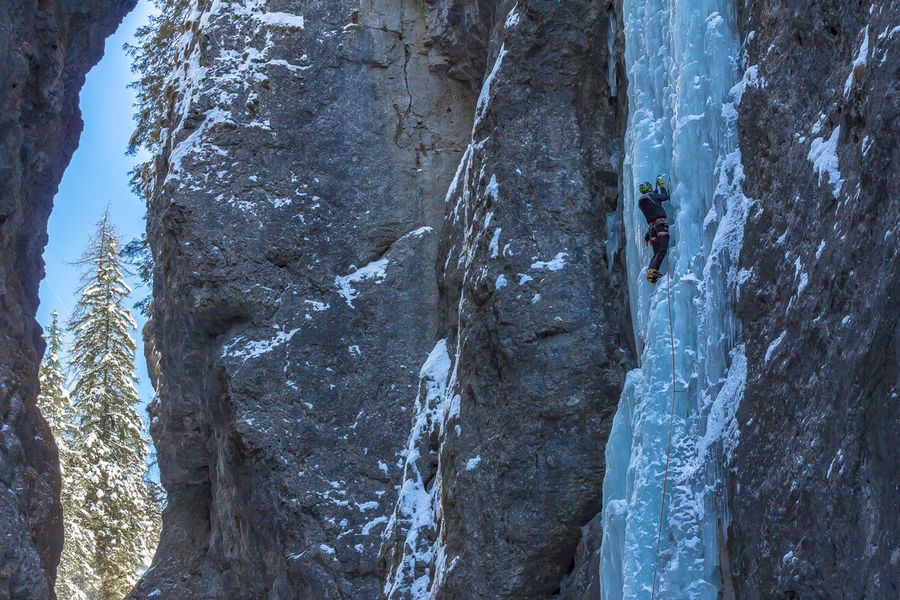
Cascata del Sole (WI-4), WI3+, 3 pitches, 80m ***
One of the few routes to receive full sunlight, this route comes with the usual caveat. However, choose an early morning ascent or a late afternoon time and you may just strike the right conditions. A massive volume of ice which funnels down to a narrow gap at its top. The access pitch climbs to a small cave with a bolted belay. You can either stop here or continue up the initial steep section to a bolted belay on the right. This is advisable for afternoon ascents as the second belay is far over to the right and out of the way of dripping water and falling ice. It also allows you to assess the condition of the upper falls which are slender at the best of times.
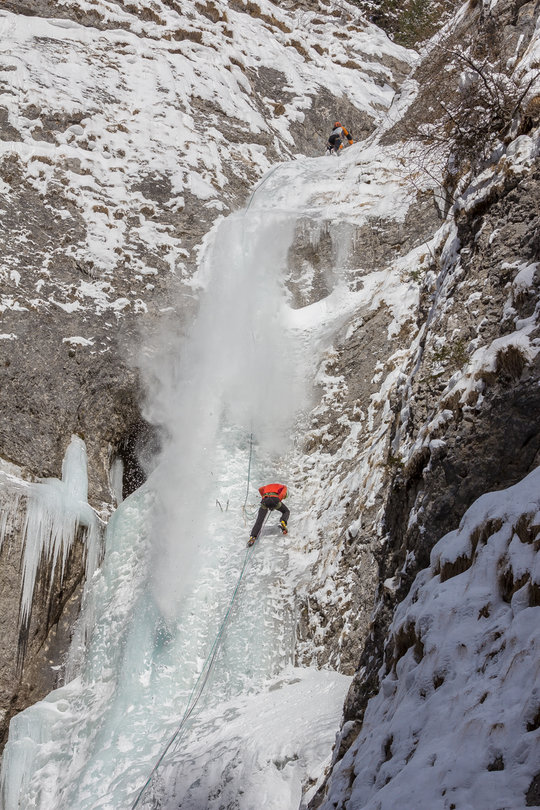
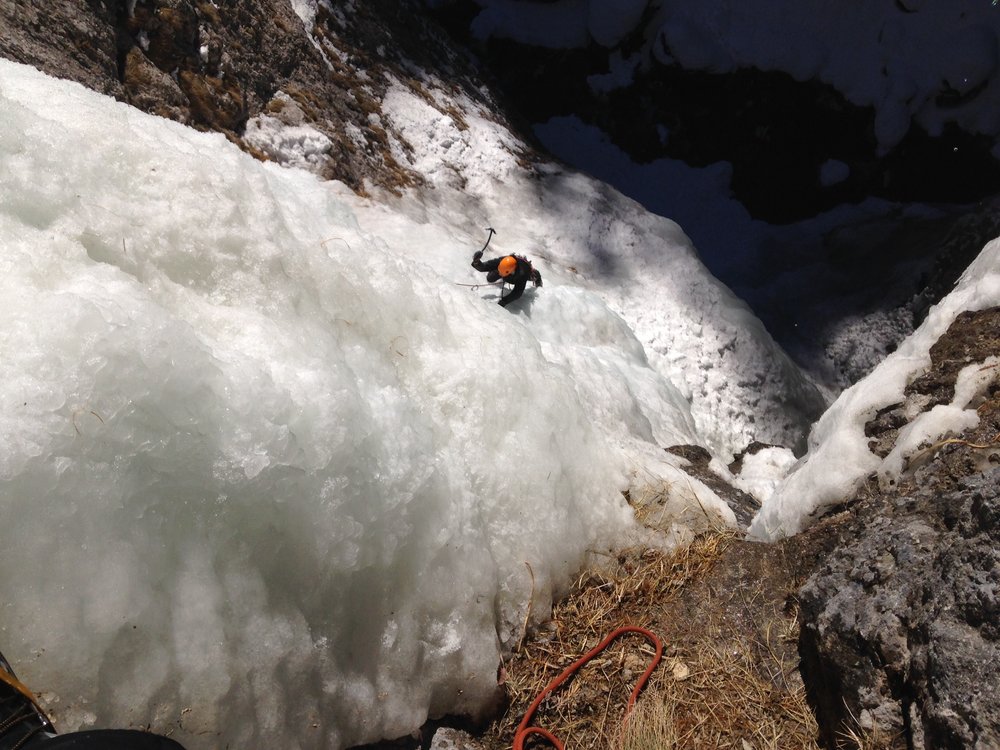
Cascata delle Attraversate (WI-4), WI4, 2-3 pitches, 100m ***
The first pitch is also climbed as an ideal beginner's/warm up route at about WI2+. At the top of this pitch, belay to the left and then climb a steep, mushroomed column to a ledge. Either belay here or continue by traversing the ledge to a final pillar. The falls can be climbed directly to the final pillar which looks to be 4+ or 5.
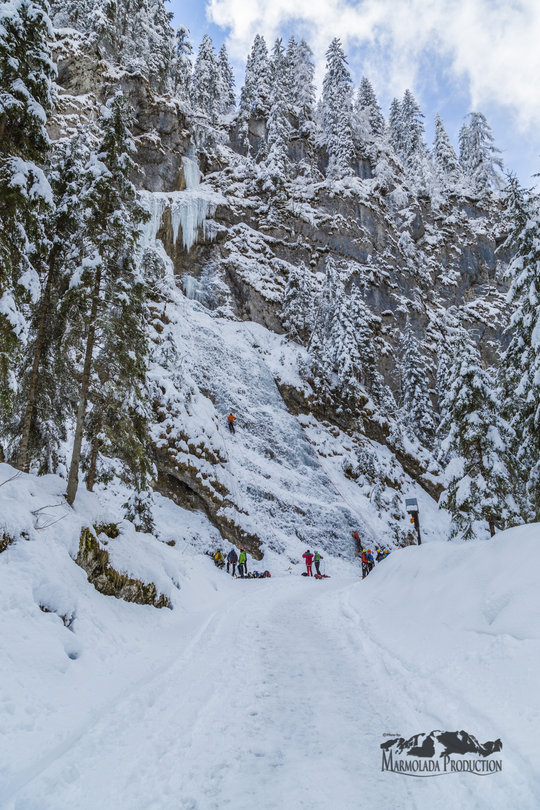
Excalibur (WI-4+) WI4+, 3 pitches, 100m ****
Winter transforms this gushing waterspout into a long, excellent route, and is considered to be the crown jewel of the gorge. The falls have a huge volume of water and so often form a thick column of ice on all the pitches. The first pitch has 2 main lines, left or right of the column whereas the top two pitches are more wall climbing, with the climber choosing their line.
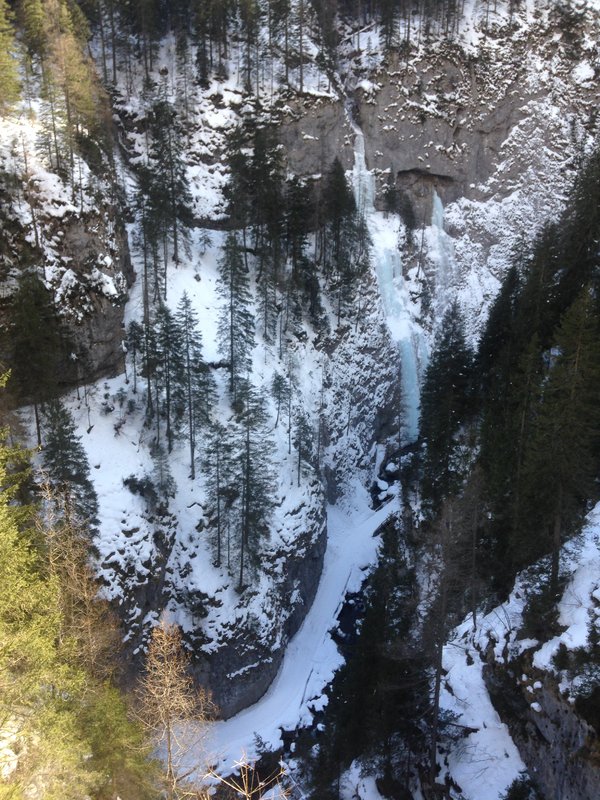
Other highlights:
Cascata della Luna (WI-4), WI4, 2 pitches, 70m** First pitch often climbed in it' own right. Two lines above.
Clessidra (WI-3+), WI3+, 1 pitch, 25m* Nice climbing although a little broken with an easier middle section.
Cascata del Gelato (WI-3), WI3, 1 pitch, 15m* Quite an enclosed line, with the upper section following an almost chimney like section.
Palestrina (WI-2), WI2, 1 pitch, 35m ** An ideal route for the beginner, or as a first ice lead.
Arbre Magique (WI-4), WI4, 1 pitch, 30m ** Right at the top of the gorge and a good bet when other routes are occupied. Cross the stream and follow the wall directly above the river and then slab.
Logistics
When to Go
With cold temperatures usually starting in November, the icefalls begin to form in December and by the end of January, the vast majority of the main lines will be climbable; by the end of February they will be fat, strong ice formations. Usually the climbing lasts until at least the end of March, but is obviously conditions dependent – later than that there are obviously still routes which can be done in the higher mountains, so although a little riskier conditions wise, with some ski touring or snow shoeing ability you can still get out on good solid ice if the gorge is out of bounds. One other thing to mention is that each year, usually towards the middle of January there is an ice climbing meeting, supported by various manufacturers. This gives an opportunity to try out axes and crampons from them and is a great opportunity to see what others get up to in the gorge.
Accommodation Advertise here
No Premier Listings found in this area
Rocca Pietore, Col di Rocca and Sottoguda are the closest villages to the gorge. Casa Alfredino in Col di Rocca offers comfortable accommodation specifically kitted out for climbers, skiers and walkers. Other than that there are numerous hotels and B&B's in the valley.
How to Get There
Val Pettorina is right at the heart of the Dolomites, away from the main tourist villages or Selva di Gardena, Corvara, Arabba and Canazei. To get here takes a 1hr 45min drive from Venice Marco Polo or 1hr and 40 min from Treviso. Either that or take a flight to Innsbruck which although a longer drive ensures that your car will be fitted with snow tyres (unlike in Italy where you have to order them and pay extra) and get to drive some of the most stunning mountain passes in the area! Not to say that the Italian side is any less stunning. On a fine day, taking the road over Passo Staulanza is an eye opener, whilst the easier drive up the Agordino valley is equally breath taking, passing beneath the soaring walls of the Bellunese Dolomites, then Monte Agner, Moiazza and finally Civetta.
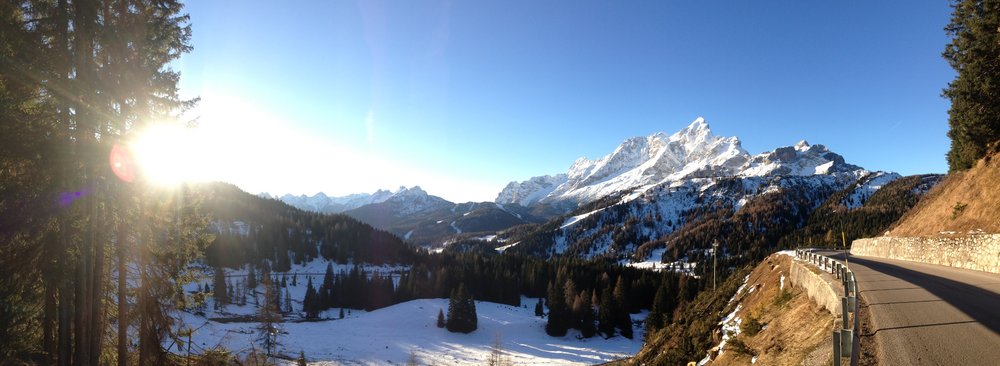
The valley itself is quite sleepy, but has everything you need to make your trip comfortable with some good restaurants, a few local shops to get essentials, some bars, a butchers shop, and cafés. The villages are picturesque and original – tourism really has only begun to get a grip on this area and so this is still an authentic mountain valley. The glitz and glamour of Cortina d'Ampezzo and Val Gardena are far away, despite only being an hour's drive.
Weather
The weather here is of course as variable as in any mountain range. Some years the Dolomites sees little snow, and often these are the best conditions of ice formation as it often indicates high pressure weather systems and stable cold spells. However the gorge is also extremely wooded above so avalanche risk is often very low. However, do be careful in the area around the road bridge as sometimes after a heavy snowfall, goods vehicles and buses rumbling over the bridge can set off spindrift avalanches! The ARPAV weather forecast is generally the most accurate for the region.
Gear
8-12 screws are the main requirement here. On the cascade routes you will rarely if ever find rock protection. Many routes have bolted belays, but be prepared as some do not so screw or Abalakov/Anderson thread belays are required. Besides, you may need to retreat for some unforeseen reason. Mixed routes are often equipped adequately with expansion bolts, but sometimes a small selection of nuts and/or cams can add to security.
In places trees provide an abseil anchor – please be aware that at the moment most insitu anchors have been put in place by individuals, so do not blindly trust their strength. Inspect (as normal) all anchors to which you trust your life, and where deemed sensible, add or entirely replace tat which may be aging or badly installed. We will slowly replace the poor quality tat around these trees with stainless chains, but this will take time, so in the meantime, please ensure you take sufficient rope with you to rig your own belay for descent. If you need more tat, screws or general gear, we can recommend De Grandi sport in Bosco Verde who stock a really good selection of equipment.
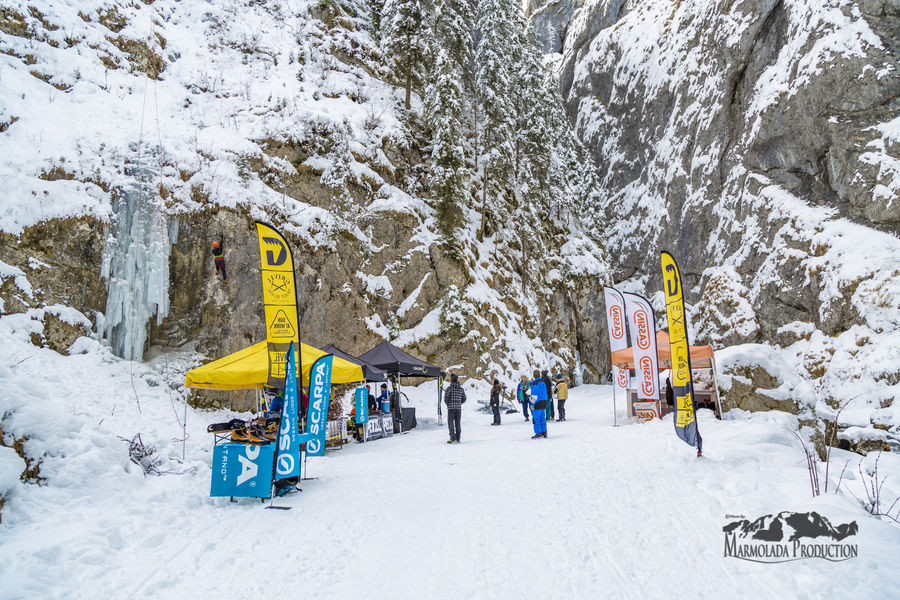
Grading
The standard grading here is the WI system with M grades on mixed routes. Sometimes UIAA grades are given but generally these aren't that far removed from the WI grade. Grades in the gorge vary from WI2 through to WI6+ and M9+. The main grade spread is around WI3+ to 4+ which makes it ideal for the intermediate ice climber.
Access
This is what makes the Serrai di Sottoguda so appealing – essentially roadside ice. The car park at the end of Sottoguda village is large and only occasionally full. From here take the small road which leads uphill into the gorge. Within 3 minutes from the car you will reach the first icefalls, and the far end of the gorge is a further 20 minute walk uphill. Alternatively you can park in Malga Ciapela and walk down into the gorge if you plan to climb higher up the valley.
Guidebooks
The best guidebook for the gorge is Ghiaccio Verticale Vol.2 which covers the Dolomites to the east of the Adige Valley and stretches as far as Slovenia. This is in Italian only, but does give graphical descriptions of some routes and their position in the gorge. It is by far the most comprehensive guide.
Alternatively there is Eisklettern in Sudtirol, which is a German language book.
Instructor/Guides Advertise here
Outdoor Shops Advertise here
No Premier Listings found in this area
Othe Activities
What to do when you fancy a day off or just want to do something else? Well the Dolomites is world famous for its piste skiing. Boasting the largest linked areas on one ski pass in the world, you simply won't run out! From Val Pettorina you can ski in the Marmolada and Arabba, Civetta, Alta Badia, Lagozuoi, Falcade/San Pellegrino and Canazei Ski Range with no more than a 35 minute drive. Indeed Marmolada is right at your doorstep, which as the tallest mountain in the Dolomites and with a large glacier to ensure good snow, one has access to a fantastic on and off piste resource. Take the lift to Monte Padon and cross over to Arabba and you will find some of the finest intermediate to advanced skiing in the Dolomites, whilst the Civetta range is ideal for those who like a more leisurely pace, with many moderate blue and red runs. Of course if off piste is more your bag, the sky is the limit with famous runs across the Sella Group like Val di Mezdi and Val Lasties, or touring ascents of Marmolada Punta Penia, Forcella di Marmolada or Forcella Franzei.
Snowshoeing in these parts is a big deal – rental of kit is available at De Grandi Sport and also from Camping Malga Ciapela, where there is a "giro del volpo" or circuit of the fox. They grant access to the mountains for those without the ability to ski. A walk up to Malga Ombretta beneath the towering walls of Marmolada will take your breath away and inspire you for the summer.
Cross Country skiing also is served at Malga Ciapela with some long circuits through the woods beneath the ramparts of Marmolada. Again, hire kit at De Grandi Sport or Camping Malga Ciapela.
Rock climbing is occasionally possible if weather is too warm for safe ice – chose a south facing or low crag and you should be OK. In fact on a warm spring day in late March I have been climbing on the south facing Civazes. If you know the abseil pistes, anything is possible. Of course sport climbing is the easiest option, and here Sas de Beita or Penia di Canazei can be an option.
Of course there is alpine climbing to be had in the area as well which can be viable in late season when the cragging ice becomes less reliable – examples are Mistica on the Torre Innerkofler, Couloir Serauta on Punta Serauta of Marmolada, or indeed the North Face of Marmolada to Punta Penia.

For a more in-depth overview, take a look at James Rushforth's excellent destination article, Dolomites - Ski Mountaineering and Snowshoeing
Watch a video of the Dolomites Ice Climbing Meeting below by Marmolada Productions:



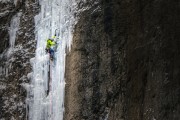


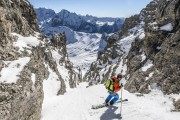





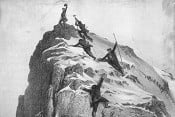
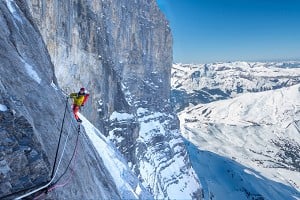

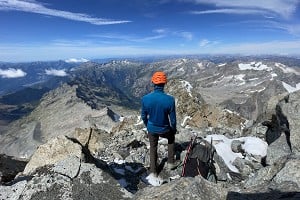
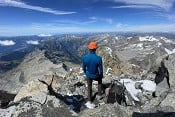



Comments